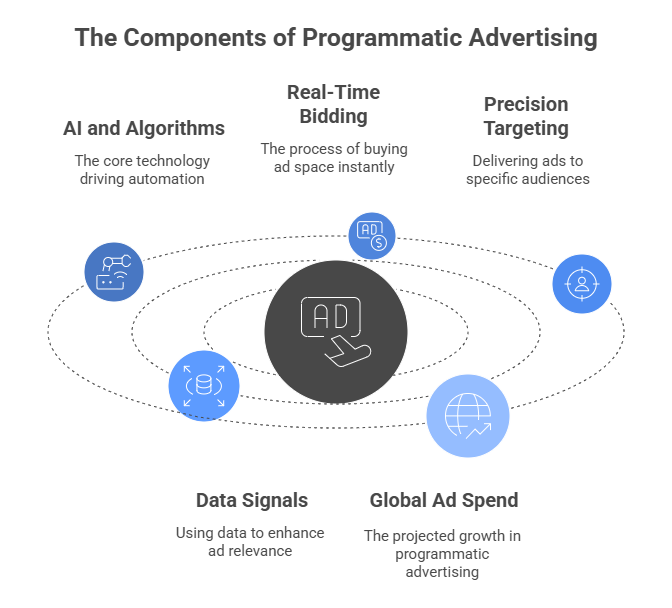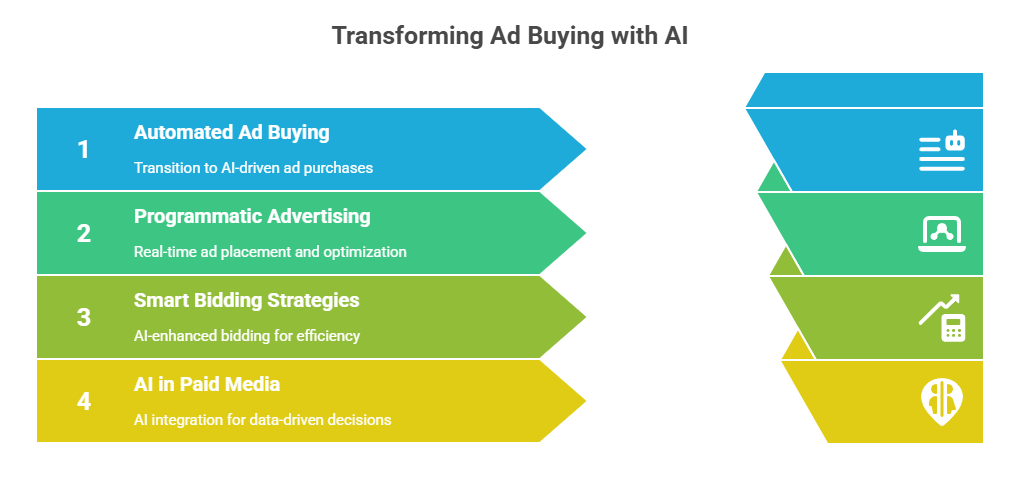
In today’s digital-first world, marketers are shifting from manual processes to automated ad buying powered by AI. One of the most transformative innovations in paid media is programmatic advertising, which enables real-time buying, placement, and optimization of ads across multiple platforms. It removes guesswork and manual labor, replacing it with data-driven, efficient decision-making.
As we head deeper into programmatic marketing 2025, understanding how smart bidding strategies and AI in paid media work together is essential for businesses that want to stay competitive, maximize ROI, and reach the right audience at the right time.

What Is Programmatic Advertising?
Programmatic advertising refers to the use of AI and algorithms to automate the buying of digital ad space. Instead of manually negotiating with publishers, programmatic systems use real-time bidding (RTB) to evaluate and purchase ad impressions as users load pages or apps.
Unlike traditional advertising, which is often time-consuming and expensive, programmatic advertising allows brands to target hyper-specific audiences with unmatched precision. It uses data signals like demographics, behavior, location, and device usage to deliver the most relevant ads—instantly.
According to Statista, global programmatic ad spend will surpass $800 billion by 2026, with over 88% of digital display ads being bought programmatically. This marks a clear trend: automation is not the future—it’s the now.

Why Programmatic Marketing 2025 Is a Game-Changer
As we approach programmatic marketing 2025, the capabilities of AI-driven ad platforms are expanding rapidly. The focus is shifting from mere automation to intelligent, predictive media buying.
Here’s why:
1. Precision Targeting with Scale
Programmatic advertising enables brands to reach niche audiences across thousands of websites, apps, and devices—without running individual campaigns for each segment.
2. Real-Time Decision Making
Using AI in paid media, platforms can analyze billions of data points in milliseconds and adjust bidding strategies in real time.
3. Cost Efficiency
With smart bidding strategies, advertisers can automatically optimize bids based on factors like time of day, device, or user behavior—ensuring every dollar works harder.
AI in Paid Media: The Engine Behind Automation
The real muscle behind programmatic advertising is artificial intelligence. Platforms like Google Ads, Facebook Ads, and DSPs (Demand Side Platforms) use AI in paid media to optimize every element of your campaign:
- Audience insights: Predict which user segments are most likely to convert.
- Creative testing: Automatically test different ad creatives to identify top performers.
- Budget allocation: Shift ad spend dynamically across platforms based on performance.
- Bid adjustments: Apply smart bidding strategies that improve ROI automatically.
In 2024, McKinsey reported that companies using AI in advertising saw a 30–50% reduction in acquisition costs compared to those using manual methods.
Understanding Smart Bidding Strategies
Smart bidding strategies are automated bid-setting mechanisms in platforms like Google Ads that use machine learning to optimize for conversions or conversion value.
Here are the most effective strategies in programmatic marketing 2025:
1. Target CPA (Cost-Per-Acquisition)
The system adjusts bids to get as many conversions as possible at your target cost.
2. Target ROAS (Return on Ad Spend)
Focuses on maximizing revenue based on your conversion value data.
3. Maximize Conversions
Automatically sets bids to help get the most conversions within your budget.
4. Enhanced CPC (eCPC)
Adjusts manual bids to improve chances of conversion without exceeding your set limit.
These smart bidding strategies enable advertisers to automate complex decision-making without losing control over budget or performance goals.
Benefits of Automated Ad Buying
Let’s look at the core benefits of shifting to automated ad buying through programmatic systems:
Speed
Campaigns can be launched, paused, optimized, and scaled instantly without human delay.
Efficiency
No need for lengthy negotiations or RFPs. Everything happens in real-time.
Optimization
Performance is constantly improved by AI—whether it’s targeting, creative, or bids.
Transparency
Access to granular analytics in real-time allows for full control and data-backed decisions.
A Deloitte study found that advertisers using automated ad buying achieved 25% higher ROI in Q1 2024 compared to traditional media buyers.
Real Results: Programmatic in Action
Let’s take a real-world example:
A fashion eCommerce brand used programmatic advertising combined with smart bidding strategies to launch a personalized retargeting campaign across Google, Facebook, and Spotify.
- CTR increased by 38%
- CPC dropped by 22%
- Conversion rates improved by 31%
- Overall ROI grew by 46% within 60 days
This was possible because the campaign used AI in paid media to identify high-intent users, adjust bids in real time, and serve hyper-relevant creative variations automatically.
How to Implement Programmatic Marketing in 2025
If you’re ready to adopt programmatic marketing 2025 trends in your business, here’s how to get started:
1. Choose the Right Platform
Select a DSP (Demand Side Platform) like Google DV360, The Trade Desk, or MediaMath depending on your target audience and budget.
2. Set Clear Goals
Are you looking for awareness, conversions, or retention? Your smart bidding strategies should align with your objectives.
3. Use First-Party Data
Leverage CRM, website, and app data to build stronger audience segments for programmatic advertising.
4. Monitor & Refine
Even with automation, don’t go fully hands-off. Analyze performance and let AI learn from clean, accurate data inputs.
The Future of Programmatic Advertising & AI in Paid Media
As privacy regulations grow tighter and third-party cookies phase out, AI in paid media will play an even bigger role in how ads are bought and optimized.
Programmatic marketing 2025 will be centered around:
- First-party data strategies
- Contextual targeting using AI
- Cross-platform unified campaigns
- Conversational and dynamic ad formats
Experts predict that by 2026, more than 92% of digital ad buys will be automated—making automated ad buying not just a strategy, but a survival necessity.
Conclusion
The combination of programmatic advertising and smart bidding strategies is redefining the landscape of digital media. With AI in paid media, marketers can launch intelligent, efficient, and scalable campaigns that outperform traditional methods by a wide margin.
If your digital strategy still relies heavily on manual control, 2025 is the year to embrace automated ad buying and let the data do the work. The brands winning tomorrow are those optimizing today—intelligently, automatically, and programmatically.
Ready to deliver truly personalized experiences? Contact Us to build hyper-personalized campaigns that convert.
If you’re a business based in South Delhi looking to strengthen your online presence, partnering with the right digital team can make all the difference. At Morphiaas, we’re more than just an SEO company in South Delhi—we’re a growth-focused partner offering complete digital solutions.
As a leading digital marketing agency in South Delhi, we specialize in SEO, performance marketing, and web design tailored to your goals. Our work as an online marketing agency in South Delhi is backed by data, strategy, and a deep understanding of the local market. Whether you need a skilled web designer in South Delhi to revamp your website or a creative SEO agency in South Delhi to boost your search rankings, we’ve got you covered.
Recognized as a top web designing company in South Delhi, we blend aesthetics with functionality to create high-converting websites. From delivering impactful SEO services in South Delhi to serving growing brands as a digital marketing agency in Saket, we’re committed to your success. Looking for the best web designing company in South Delhi or experienced ad agencies in South Delhi? Let Morphiaas be your trusted partner in digital growth




